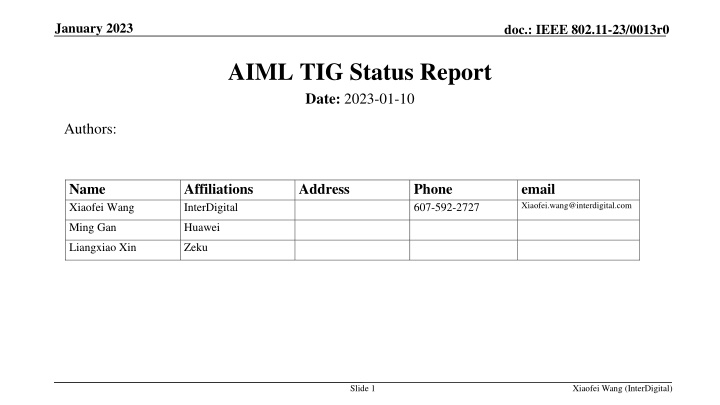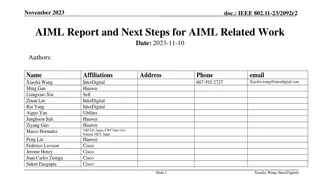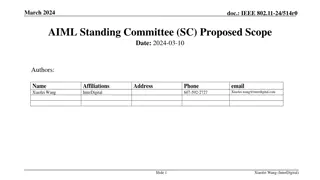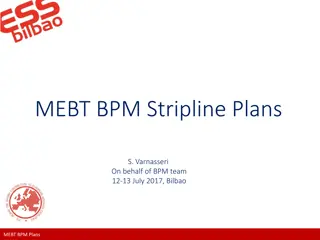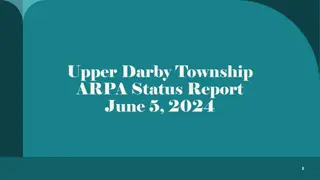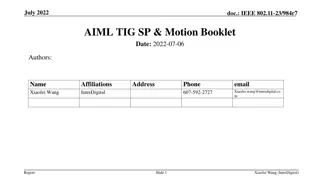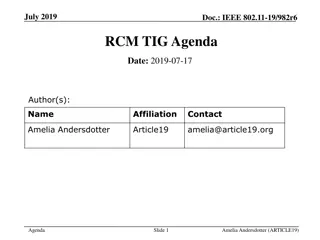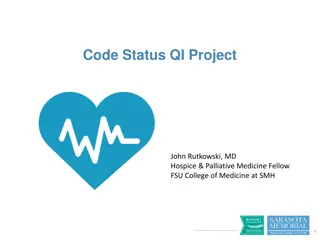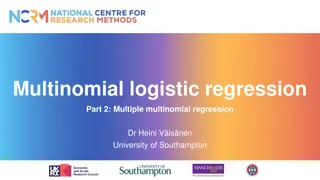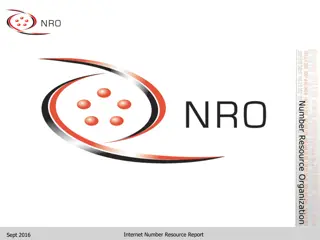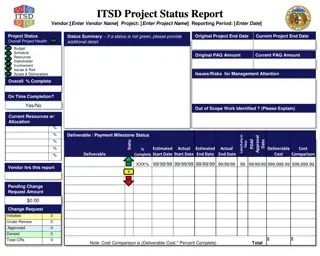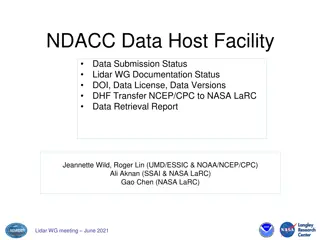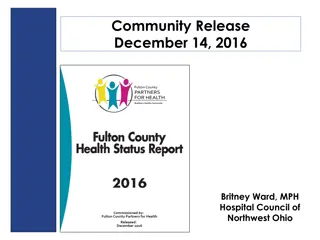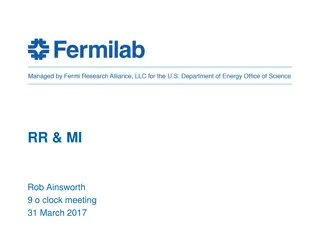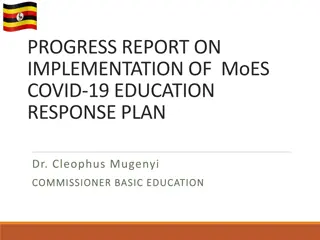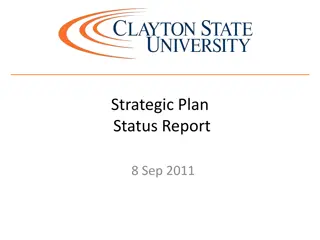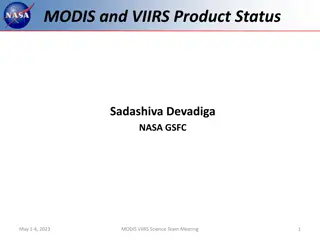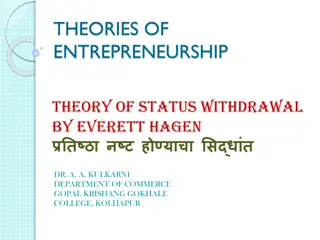AIML TIG Status Report
This document provides a status report on the Artificial Intelligence and Machine Learning Topic Interest Group (AIML TIG) within IEEE 802.11 for January 2023. It covers the formation, goals, activities, identified use cases for WLANs, and more.
Uploaded on Feb 23, 2025 | 0 Views
Download Presentation

Please find below an Image/Link to download the presentation.
The content on the website is provided AS IS for your information and personal use only. It may not be sold, licensed, or shared on other websites without obtaining consent from the author.If you encounter any issues during the download, it is possible that the publisher has removed the file from their server.
You are allowed to download the files provided on this website for personal or commercial use, subject to the condition that they are used lawfully. All files are the property of their respective owners.
The content on the website is provided AS IS for your information and personal use only. It may not be sold, licensed, or shared on other websites without obtaining consent from the author.
E N D
Presentation Transcript
January 2023 doc.: IEEE 802.11-23/0013r0 AIML TIG Status Report Date: 2023-01-10 Authors: Name Xiaofei Wang Affiliations InterDigital Address Phone 607-592-2727 email Xiaofei.wang@interdigital.com Ming Gan Huawei Liangxiao Xin Zeku Slide 1 Xiaofei Wang (InterDigital)
January 2023 doc.: IEEE 802.11-23/0013r0 Abstract Status report for the AIML (Artificial Intelligence Machine Learning) TIG Slide 2 Xiaofei Wang (InterDigital)
January 2023 doc.: IEEE 802.11-23/0013r0 Overview AIML TIG and its mandate AIML TIG goals and activities Highlights of AIML use cases identified for IEEE 802.11 WLANs Conclusions Slide 3 Xiaofei Wang (InterDigital)
January 2023 doc.: IEEE 802.11-23/0013r0 AIML TIG and its mandate The AIML TIG is formed by the following WG motion in the July 2022 session [1]: Motion 5: TIG Re: AI/ML use in 802.11 Approve formation of a Topic Interest Group (TIG) to: (a) describe use cases for Artificial Intelligence/Machine Learning (AI/ML) applicability in 802.11 systems and (b) investigate the technical feasibility of features enabling support of AI/ML. The TIG is to complete a report on this topic at or before the March 2023 session. Moved: Stephen McCann, Second: Marc Emmelmann Result: Yes: 119, No: 22, Abstain: 27 (Motion passes) Slide 4 Xiaofei Wang (InterDigital)
January 2023 doc.: IEEE 802.11-23/0013r0 AIML TIG Goals and Activities The goals for the AIML TIG are NOT to define or standardize AIML models AIML TIG has been fortunate to have some AIML experts providing tutorials Tutorials are valuable to provide background on AIML and academic research available on the topic Tutorials provide an understanding of AIML, supporting the TIG s standards-focused work The goals and work for the AIML TIG closely follow our mandate Study and describe AIML use cases that are applicable to 802.11 networks With a strong focus on standards impact on IEEE 802.11 specs For each use case, the following aspects are being defined: Standards impact KPIs Requirements Technical feasibility Slide 5 Xiaofei Wang (InterDigital)
January 2023 doc.: IEEE 802.11-23/0013r0 Highlights of AIML Use Cases Identified for WLANs (1) We highlight in this report AIML use cases that have technical report text proposals AIML-based CSI Feedback Compression [3] Deep-learning based distributed channel access [4] Efficient AIML model sharing [5] Additional use cases may be included in the technical report when technical report text proposal is available E.g., ML-based adaptive subcarrier grouping for beamforming feedback [6] Slide 6 Xiaofei Wang (InterDigital)
January 2023 doc.: IEEE 802.11-23/0013r0 Highlights of AIML Use Cases Identified for WLANs (2) AIML-based CSI Feedback Compression [3] Sounding procedures in WLANs represent large overhead particularly with potential new features: Higher number of spatial streams, e.g., 16 Multi-AP features such as joint transmissions Study has shown that AIML algorithms may efficiently reduce CSI feedback and improve system throughput E.g., using unsupervised learning algorithms to significantly reduce CSI feedback into clusters while maintaining similar PER performance Standards impact: Additional signaling between AP an STAs required by AIML process to provide feedback and cluster information KPIs: CSI airtime reduction/additional AIML process overhead PER Computation complexity/latency Slide 7 Xiaofei Wang (InterDigital)
January 2023 doc.: IEEE 802.11-23/0013r0 Highlights of AIML Use Cases Identified for WLANs (3) Deep-learning based distributed channel access [4] Performances of traditional WLAN channel access designs such as DCF degrade in dense deployment, unable to support stringent QoS requirements such as Ever increasing throughput Low latency Study has shown that deep learning algorithms can efficiently increase throughput and reduce latency and jitter while maintain fairness to other devices E.g., using Deep reinforcement learning for contention window optimization E.g., AIML algorithm selects whether to transmit after the channel has been idle for DIFS Standards impact: Signaling and protocols related to parameter exchange between AP and non-AP STAs, e.g., capability indication, data report to facilitate training, neural networks parameters distribution, etc. KPIs: Throughput improvement Latency and jitter reduction Additional complexity Slide 8 Xiaofei Wang (InterDigital)
January 2023 doc.: IEEE 802.11-23/0013r0 Highlights of AIML Use Cases Identified for WLANs (4) Efficient AIML model sharing/distribution [5] Efficient AIML model distribution is essential for many AIML-based operations in WLANs and for performance of WLANs In centralized learning/federated learning, large amount of traffic are used to distribute AIML models/training data among participating devices (STAs and APs), in UL, DL and P2P links Efficient AIML model distribution protocols are needed to enable support AIML operations Including sharing of all AIML models (e.g., for other applications; these model sharing is expected to be carried by WLANs anyway), not just for models used to improve WLAN performance Efficient AIML model distribution can leverage the broadcast nature of WLANs 802.11bc defines UL/DL broadcast services for both associated and unassociated STAs/APs, providing a good set of baseline tools for AIML model distribution Standards impact: Architecture that enables AL/ML model sharing on the MAC layer Signaling and protocols related to AIML model sharing support/capability indication and management KPI: medium occupation time saving compared to model sharing using application layer data Slide 9 Xiaofei Wang (InterDigital)
January 2023 doc.: IEEE 802.11-23/0013r0 Conclusion The AIML TIG s activities closely follow our mandate Study and describe AIML use cases that are applicable to 802.11 networks With a strong focus on standards impact on IEEE 802.11 specs i.e., changes needed to enable/utilize/facilitate AIML operations in current 802.11 specs AIML TIG is not defining/specifying AIML models AIML TIG is diligently working on the technical report to the WG For a better understanding of AIML TIG s effort, WG members are invited to read the proposed AIML TIG technical report text [2][3][4][5] AIML TIG plans to discuss the next steps soon For any questions, please feel free to reach out to me Xiaofei.wang.us@ieee.org Slide 10 Xiaofei Wang (InterDigital)
January 2023 doc.: IEEE 802.11-23/0013r0 References [1] 11-22/597r3: May 2022 Working Group Motions, May 18, 2022 [2] 11-22/987r3: AIML TIG Technical Report Draft [3] 11-22/1934r5: Proposed AIML TIG Technical Report Text for the CSI Feedback Compression Use Case [4]11-22/2119r1: Proposed AIML TIG Technical Report Text for the Distributed Channel Access Use Case [5] 11-23/0050r2: Proposed AIML TIG Technical Report Text for the AIML Model Sharing Use Case [6] 11-23/0032r3: ML-based Adaptive Subcarrier Grouping for Beamforming Feedback Slide 11 Xiaofei Wang (InterDigital)
